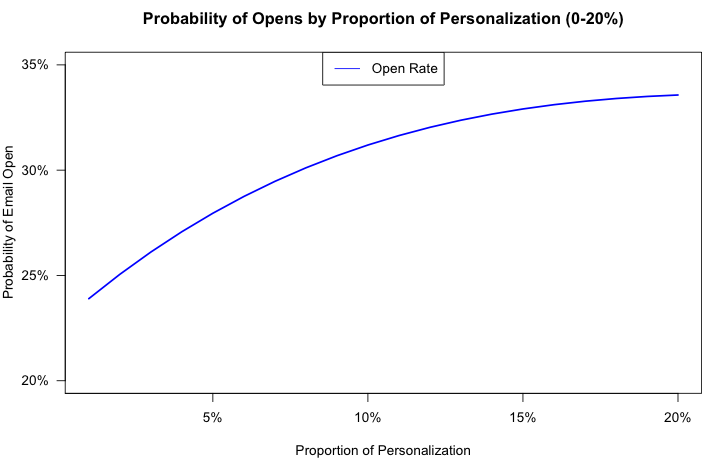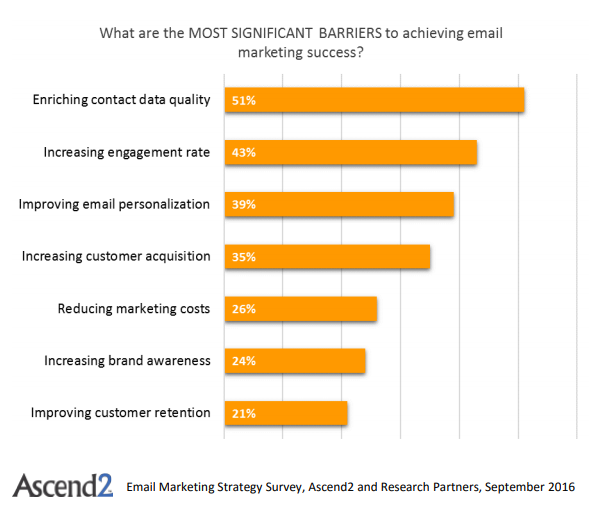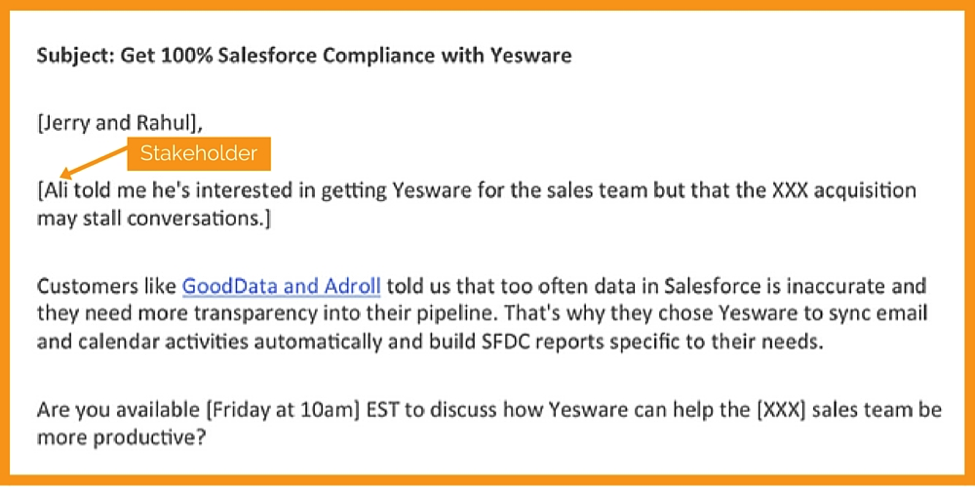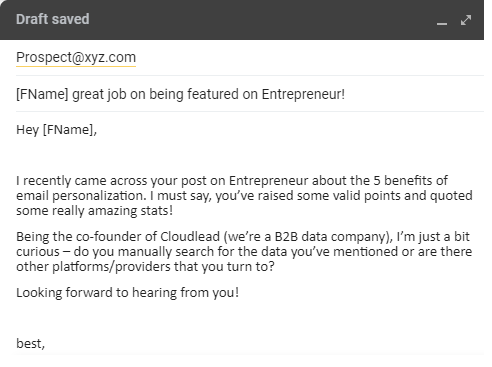Want to form a connection with a prospect?
Personalize your outreach.
To say that we are living in the age of personalization would be an understatement. And there is absolutely no doubt in any salesperson’s mind that a ‘one-size-fits-all’ approach still works.
Instead, modern businesses are moving to meet their customers demand for relevant and customized experiences through email personalization. As such, it’s really no surprise that a majority of marketers (94%) believe that personalization is a crucial aspect of their success.
Sadly, despite the wealth of data we have access to today, we don’t always manage to leverage it to its full potential. In other words, even though a majority of businesses have realized the benefits of personalization, they have a hard time implementing this approach in their overall strategy. This is one of the main reasons why only 5% of companies report that they extensively personalize their communication.
One of the main problems here is that we don’t understand how to actually put words to action – or how to personalize with the help of data. According to a report by Adobe, about 60% of marketers find it difficult to personalize content in real time.
But let me tell you something – email personalization is incredibly easy if you have the right data tools at your disposal. In fact, there are multiple ways you can personalize your communication besides the usual ‘first name’ and ‘company name.’
What Is Email Personalization?
By its very definition, a personalized email is one that speaks to the recipient directly and builds a positive experience with the brand. It gives them a reason to open your email, read through your message and most importantly, respond to you.
Besides using the prospect’s name and mentioning their company, personalization goes beyond the usual tactics. It leverages the power of data (firmographics, technographics, behavioral, etc.) to help salespeople and marketers segment their lead lists, understand a prospect and connect with them.
Before diving into the ‘how,’ let’s first fully explore the ‘why.’
Read: The 6 Types of B2B Data For Email And Call Personalization
Benefits And Statistics On Email Personalization
Let’s start with the benefits that most are aware of.
Benefit number 1: Higher open rates
Emails with a personalized subject line can lead to 50% more opens. [Yes Marketing]
Emails with personalization in the body and subject line have an open rate of 24.18%. [Get Response]
In 2016, emails with a personalized message had an open rate of 18.8% compared to those without any personalization (13.1%). [Statista]
Source: Salesloft
Benefit number 2: More engagement
74% of marketers believe that targeted email personalization leads to increased customer engagement. [eConsultancy]
50% of companies believe that personalization can help increase interaction within emails. [Experian]
91% of people say that they are more likely to opt for companies that invest in email personalization. [Accenture]
Reply rates at 20% personalization in an email increased to 6.6% from 3.1% at no personalization. [Salesloft]
Benefit number 3: Increased sales, revenue and ROI
Personalized email campaigns can lead to an increase in revenue by 5%-15%. [Adweek]
Segmented and personalized campaigns can increase revenue by 760%. [Campaign Monitor]
Personalized emails yield a median ROI of 122%. [Instapage]
Benefit number 4: Improved domain and sender score
Personalization leads to increased open and click-through rates – in short, it boosts recipient engagement. In turn, this leads to less unsubscriptions and spam complaints, and positively impacts your email deliverability. Combined, these factors improve your domain reputation and sender reputation/score.
Read: 4 Tips To Ace Email Deliverability Check And Sender Score
What Can you Personalize In A Sales Email
Now that we know the importance of personalization – and the various benefits it brings – let’s explore what elements we can actually personalize in an email.
With the help of proper outreach tools like Reply.io and a data provider like Cloudlead, you can personalize practically every aspect of your campaign. This includes something as basic as addressing the recipient by name to more advanced techniques like buying intent signals.
Source: Ascend2
Here is a list of things you can include to personalize your communication:
- First name
- Company name
- Location
- Technology being currently used
- TAM quote
- Employee turnover
- Buying signals like:
- Recent funding
- New hiring
- Recent promotion
- Technology shift/contract ending for certain technology
- Hobbies
- Common/mutual connections
- Quote from the prospect (taken from a recent article they’ve written for instance)
- Mention recent articles/posts liked by the prospect
- Images/personalized demo videos
- Gifs that showcase how your product can help the client specifically
Of course, there are a number of other factors that you can personalize and include in your campaigns, depending on your industry and target audience. These are just some ideas to get you started – remember, a good B2B data vendor can provide most of these triggers and data points to you.
Cold Email Personalization Tips And Techniques
Subject Line
Be direct, use the recipient’s name or the company name to create a subject line that is in line with your email body.
Another idea is to create a personalized offer – e.g. exclusive trial – and don’t forget to mention it in the email.
For example:
Segment Your Email List
Whether you choose to segment according to geolocation, pain points, tech used or multiple such factors, know that a targeted approach can increase your engagement rates significantly.
Source: Yesware
Praise The Prospect
Even though this is not something new, the simple fact is that people love being praised.
Subtle compliments can help you create a connection with the prospect – simply mention how informative their last article was or how a recent interview/podcast they were featured in helped you learn more about the field.
This type of information can be gathered through social platforms like LinkedIn, Twitter, etc.
Here’s an example:
Bottom Line
With more businesses turning towards email personalization as a part of their sales and marketing strategy, it is extremely necessary to know how to do it well. Be sure to select the right tools and data partners for your business to start reaping the benefits.















